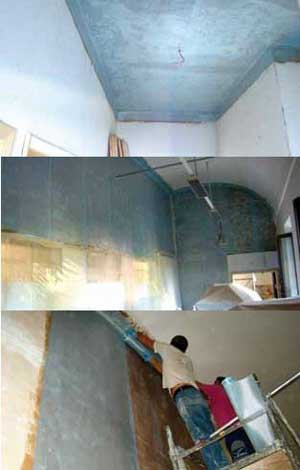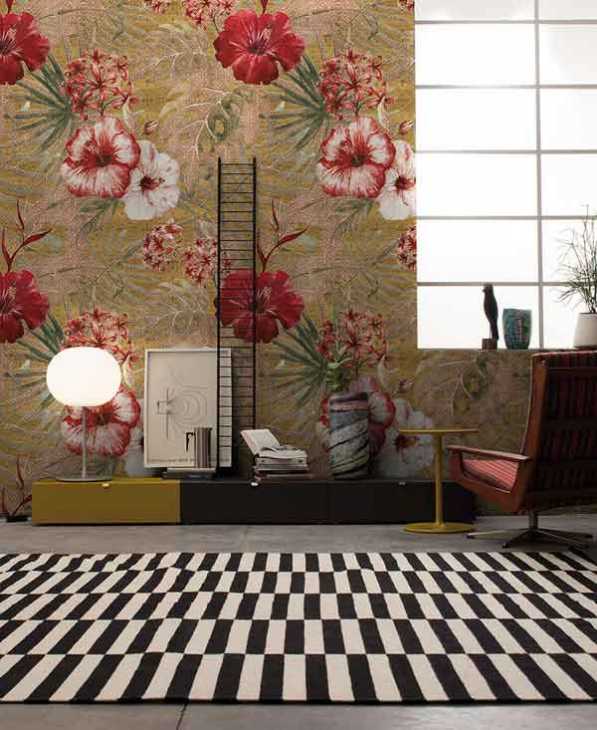Anti-seismic wallpaper
Post from EditorialsThe anti-seismic wallpaper makes the walls more resistant, guarantees greater safety for the safety of human beings and guarantess also time to evacuate in case of earthquakes.
Anti-seismic wallpaper: protective and decorative
Italy is a country with high seismic risk since it is subject, for its geographical position, to violent actions of compression; Therefore, new buildings have to take into account the latest standards and anti-seismic techniques in order to limit the damage, ponder the criteria on which to base the design and use appropriate materials.
According to tradition, an anti-seismic building consists of reinforced concrete of strength class specific to the area, of wood for its good ability to flex and in any case with high strength, steel for its ductility and finally also brick compound if so sufficient to withstand the sussultatory fluctuations especially since these, specifically, create cracks in the walls making it very unstable.
About composed masonry bricks works, have been introduced on the market, the anti-seismic wallpapers which have the dual function of making the wall more resistant, so as to increase at least the time to evacuate people in the event of seismic phenomena, therefore, to limit the damage and simultaneously ensure the decorative function, because you can choose between various graphic textures designed for environments in various styles and combinations of all kinds.
What is the anti-seismic wallpaper?
The invention was made by a group of scientists at KIT, acronym of Karlsrhue Institute of Technology, joined to the Institute of research Bayer, it has set itself the goal to curb the collapse of walls at a earthquake to reduce hazards for those who find themselves inside a house since the vulnerability of a building depends not only on structural elements, but also on non-structural, on partitions.
The first material taken into consideration was the carbon fiber and only consequently, in 2010, have focused more precisely on the glass fiber, winning material, resistant, especially because of its elastic properties, combined with a special polyurethane based adhesive with water-repellent characteristics which cause, after the application, the water is expelled, and the paper is kept adherent to the wall.
The company Mapei, in collaboration with the group of scientists, has marketed this product highly technological patented retrievable by the name of Mapewrap EQ System.
Mapewrap EQ System consists of two layers:
- An adhesive, or a single component adhesive and ready to use in aqueous dispersion, called Mapewrap EQ Adhesive;
- A bidirectional fiber glass scaffolding, treated with substances which make it waterproof and consistent, called Mapewrap EQ Net.
Application of anto-seismic wallpaper
 One of the advantages of this special wallpaper is the ease of application
One of the advantages of this special wallpaper is the ease of application
It provides for a first operation relating to the preparation of the support; the quality and accuracy of the latter are determined to ensure successful installation of wallpaper, whether or not earthquake-proof.
It needs, then, to eliminate all the superficial traces of existing paint.
Afterwards, we proceed by applying a first coat of Mapewrap EQ Adhesive, then the fabric Mapewrap EQ Net, a second coat of glue, to end with the execution of shaving the wall.
This operation is usually achieved with monocomponent cementitious mortar with high adhesion.
To complete the application procedure make a surface finish by means of a small wet sponge.
Characteristics and properties of the anti-seismic wallpaper
The properties are so many and in fact can be summarized by saying that a material is thin and light, of rapid application, the reinforcement technique is not invasive, versatile for its adaptability for both indoor and outdoor spaces, for both buildings and then houses, both public spaces, perhaps including those of historical and monumental value, preserving the character of cultural heritage and therefore of low architectural impact.
This invention has undergone a new development when they took over the collaboration with the company Inkiostro Bianco from Sassuolo, for some time producer of wallpapers.
The company has promoted the product Dekor EQ that has at the base Mapewrap EQ System and it is essentially a printed fabric of glass fiber with a series of decorative graphics, in whole 60, which allow to leave the fiber-reinforced layer in view and thus in full agreement with the chosen style for the environment in which it is inserted.
It is a truly exceptional product to be taken into account at both public and private spaces, both areas in which you need to protect the safety of people even without paying attention to aesthetics and then inserting a non printed glass fiber fabric, not decorative or also in areas where the aesthetic has some importance, considering the latest type.
Regarding cladding and brick partitions, also the company Rofix has fielded an efficient solution both from a point of view of anti-seismic performance and of energy efficiency of the buildings.
The system is called ROFIX SismaCalce, it integrates very well with the system of external foamed insulation chosen according to the requirements and performance of thermo hygrometric that are to get.
ROFIX Sisma Lime is precisely an hydraulic lime based mineral mortar, flexible and with low modulus of elasticity, suitable both for new buildings and existing buildings, to support the special network ROFIX SismaProtect, in both glass and synthetic fibers.
As with the previous product, also for this one have been carried out tests in the laboratory, in this case at the Department of Civil Engineering, Construction, Environmental, of the University of Padua, which has proven the efficiency of the system for thermal insulation coat and anti-seismic reinforcement.
The fundamental fact to keep in mind during a design is to make so that the building, the structure, resists as long as possible, especially by mitigating the seismic risk, ensuring greater safety for users, and consequently also increasing the value of the property.
79806 REGISTERED USERS










